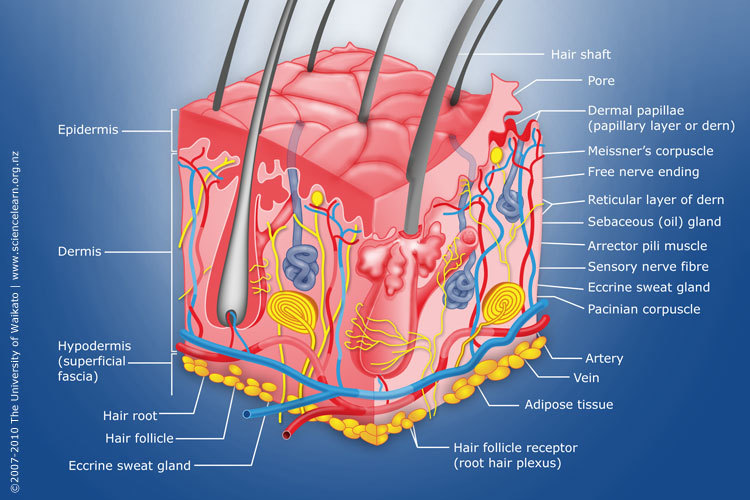The skin is the largest organ of the body, regenerating itself every 27 days. Weighing an average of six pounds, it acts as a waterproof insulation from the outside (sunlight, chemicals, and temperature). It also acts as an antibacterial barrier and emits Vitamin D in order to convert the vitamin to calcium to help maintain bones. It aids in mobility and is jam-packed with nerves to keep the brain in touch with what is happening in the world around it. This amazingly diverse organ fulfills an array of responsibilities in the body and it the most of what we present to the world, making it amazingly versatile.
Link
Skin Facts |
The Integumentary System pt 1 |
1.The average adult has approximately 21 square feet of skin, which weighs 9 lbs and contains more than 11 miles of blood vessels.
| |||||||
| skin_concept_planner.docx | |
| File Size: | 21 kb |
| File Type: | docx |
The Integumentary System pt 2
Words to Know
Integumentary System the organ system that protects the body from various kinds of damage, such as loss of water or abrasion from outside. The system comprises the skin and its appendages (including hair, scales, feathers, hooves, and nails)
Epidermis the outer layer of cells covering an organism, in particular
Dermis the thick layer of living tissue below the epidermis that forms the true skin, containing blood capillaries, nerve endings, sweat glands, hair follicles, and other structures
Subcutis superficial fascia, is the lowermost layer of the integumentary system in vertebrates.
Regenerate to replace lost or injured tissue
Melanin a dark brown to black pigment occurring in the hair, skin, and iris of the eye in people and animals. It is responsible for tanning of skin exposed to sunlight.
Elastin a protein forming the main constituent of elastic connective tissue, found especially in the dermis of the skin.
Collagen the main structural protein found in skin and other connective tissues, widely used in purified form for cosmetic surgical treatments
Sweat Gland regulates body temperature. When internal temperature rises, the eccrine glands secrete water to the skin surface, where heat is removed by evaporation.
Get the full word list here.
Epidermis the outer layer of cells covering an organism, in particular
Dermis the thick layer of living tissue below the epidermis that forms the true skin, containing blood capillaries, nerve endings, sweat glands, hair follicles, and other structures
Subcutis superficial fascia, is the lowermost layer of the integumentary system in vertebrates.
Regenerate to replace lost or injured tissue
Melanin a dark brown to black pigment occurring in the hair, skin, and iris of the eye in people and animals. It is responsible for tanning of skin exposed to sunlight.
Elastin a protein forming the main constituent of elastic connective tissue, found especially in the dermis of the skin.
Collagen the main structural protein found in skin and other connective tissues, widely used in purified form for cosmetic surgical treatments
Sweat Gland regulates body temperature. When internal temperature rises, the eccrine glands secrete water to the skin surface, where heat is removed by evaporation.
Get the full word list here.
Additional Resources
|
Great Lakes Science Center, located in Cleveland, Ohio, is another science-based education center geared towards all ages. Link |
Want more in depth content knowledge?
|




